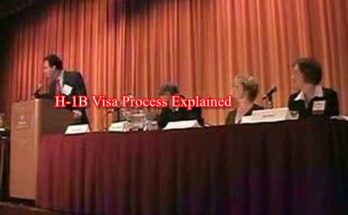The H-1B visa is a popular nonimmigrant visa that allows U.S. employers to temporarily employ foreign workers in specialty occupations. Understanding the H-1B visa process is essential for both employers seeking to hire skilled international professionals and individuals aiming to work in the United States. This guide provides a thorough overview of the H-1B visa, detailing every step of the application process, eligibility criteria, and other important considerations.
What is an H-1B Visa
The H-1B visa is a nonimmigrant visa that permits U.S. employers to temporarily employ foreign nationals in specialty occupations. Specialty occupations require theoretical and practical application of a body of specialized knowledge, typically necessitating a bachelor’s degree or higher in a specific field, A Comprehensive Guide to the H-1B Visa Process
Key Features of the H-1B Visa
Duration: The H-1B visa is initially granted for up to three years, with the possibility of extension for a total of up to six years.
Employer-Specific: The visa is employer-specific, meaning it is tied to the job with the sponsoring employer. If you want to change employers, a new H-1B petition must be filed.
Dual Intent: H-1B visa holders are allowed to pursue permanent residency (a Green Card) while on the H-1B visa, which is known as “dual intent.”
Benefits of the H-1B Visa
For Employees
Work Authorization: Allows foreign nationals to work legally in the U.S. in their field of expertise.
Family Accompaniment: Dependents (spouses and children under 21) can accompany the H-1B holder on an H-4 visa. Spouses may apply for work authorization under certain conditions.
Path to Permanent Residency: H-1B visa holders can apply for a Green Card while in the U.S.
For Employers
Access to Global Talent: Enables employers to hire highly skilled professionals from around the world.
Skill Enhancement: Allows businesses to benefit from specialized skills and expertise not readily available in the U.S. labor market.
Eligibility Requirements for the H-1B Visa
To qualify for an H-1B visa, both the employer and the employee must meet specific eligibility criteria, A Comprehensive Guide to the H-1B Visa Process
For Employees
Specialty Occupation: The job must require a bachelor’s degree or higher in a specific field related to the job duties.
Educational Qualifications: The employee must have at least a U.S. bachelor’s degree or its equivalent in the field of the specialty occupation. In some cases, work experience may substitute for formal education.
Job Offer: The employee must have a valid job offer from a U.S. employer willing to sponsor the visa application.
For Employers
Employer Requirements: The employer must be a U.S. entity with a legitimate business and the ability to pay the offered wage.
Labor Condition Application (LCA): The employer must file an LCA with the U.S. Department of Labor, attesting to the wage and working conditions for the H-1B employee.
The H-1B Visa Application Process
The process of applying for an H-1B visa involves several steps, including filing petitions, obtaining approvals, and complying with legal requirements. Here is a detailed overview, A Comprehensive Guide to the H-1B Visa Process
Employer’s Preparation
Determine the Need for H-1B Visa
The employer must determine if the position meets the requirements of a specialty occupation and if the employee’s qualifications align with the job requirements, A Comprehensive Guide to the H-1B Visa Process
Prepare the Labor Condition Application (LCA)
Filing the LCA: The employer must file the LCA with the U.S. Department of Labor (DOL). The LCA includes details about the job, wages, and working conditions.
Wage Requirements: The employer must pay the H-1B employee at least the prevailing wage for the occupation in the geographic area or the employer’s actual wage, whichever is higher.
Certification: Once the LCA is certified by the DOL, it is valid for up to three years.
2. Petition Filing
Complete Form I-129
Form I-129: The employer files Form I-129, Petition for a Nonimmigrant Worker, with U.S. Citizenship and Immigration Services (USCIS). This form includes details about the job, employee, and employer.
Supporting Documentation: The petition must include the certified LCA, evidence of the employee’s qualifications, and the job description.
Pay the Required Fees
The employer must pay several fees, including:
Base Filing Fee: Covers the cost of processing the petition.
ACWIA Fee: A fee to fund training programs for U.S. workers.
Fraud Prevention and Detection Fee: A fee to prevent and detect fraud in the H-1B program.
Premium Processing Fee (optional): An additional fee for expedited processing, if desired.
USCIS Processing
Receipt Notice
Once USCIS receives the petition, they issue a receipt notice to the employer. This notice confirms that USCIS has accepted the petition for processing, A Comprehensive Guide to the H-1B Visa Process
Request for Evidence (RFE)
USCIS may issue a Request for Evidence (RFE) if they need additional information to make a decision. The employer must respond to the RFE within the specified timeframe, A Comprehensive Guide to the H-1B Visa Process
Petition Approval
If USCIS approves the petition, they will issue an approval notice (Form I-797). The approval notice is essential for the visa application process, A Comprehensive Guide to the H-1B Visa Process
Visa Application
If the employee is outside the U.S., they must apply for an H-1B visa at a U.S. embassy or consulate, A Comprehensive Guide to the H-1B Visa Process
Schedule a Visa Interview
The employee must schedule and attend a visa interview at the nearest U.S. embassy or consulate. They should bring required documents, including the approval notice, passport, and application forms.
Visa Issuance
If the visa application is approved, the employee will receive an H-1B visa stamp in their passport, allowing them to enter the U.S,A Comprehensive Guide to the H-1B Visa Process
Entry to the U.S.
Upon receiving the visa, the employee can enter the U.S. and start working for the sponsoring employer. It is important to present the visa and other required documents to the Customs and Border Protection (CBP) officer at the port of entry.
Key Considerations and Challenges
Cap on H-1B Visas
The H-1B visa program has an annual cap, limiting the number of new H-1B visas issued each fiscal year. As of recent years, there is a general cap of 65,000 visas, with an additional 20,000 visas available for individuals with advanced degrees from U.S. institutions. The cap often leads to a lottery system due to high demand.
Maintaining Status
H-1B visa holders must maintain their status by adhering to visa conditions, including working for the sponsoring employer in the specified role and location. Any significant changes, such as job changes or long absences, can affect their status.
Visa Extensions and Transfers
H-1B visas can be extended for up to three additional years, totaling a maximum of six years. If changing employers, the new employer must file a new H-1B petition, although it does not count against the annual cap if the individual is already in H-1B status.
Impact of Changes in Immigration Law
Immigration policies and regulations can change, impacting the H-1B visa process. Staying informed about current laws and seeking legal advice if needed can help manage these changes, A Comprehensive Guide to the H-1B Visa Process
Spouse and Dependent Visas
H-1B visa holders can bring their spouse and children under 21 to the U.S. on an H-4 visa. The spouse may apply for work authorization under certain conditions, such as when the H-1B holder has an approved I-140 petition for a Green Card.
Conclusion
The H-1B visa process, while complex, provides valuable opportunities for both employers and foreign nationals. Understanding the requirements and procedures involved in obtaining an H-1B visa is essential for ensuring a successful application and compliance with immigration laws.
For employers, the H-1B visa process allows access to a global talent pool, enhancing business capabilities and fostering growth. For employees, it provides a pathway to work in the U.S. and pursue long-term career goals.
Navigating the H-1B visa process requires careful preparation, adherence to legal requirements, and attention to detail. By following the outlined steps and considering key factors, both employers and employees can effectively manage the process and achieve their immigration objectives.
If you have specific questions or need further assistance, consulting with an immigration attorney can provide expert guidance and support throughout the H-1B visa process.




